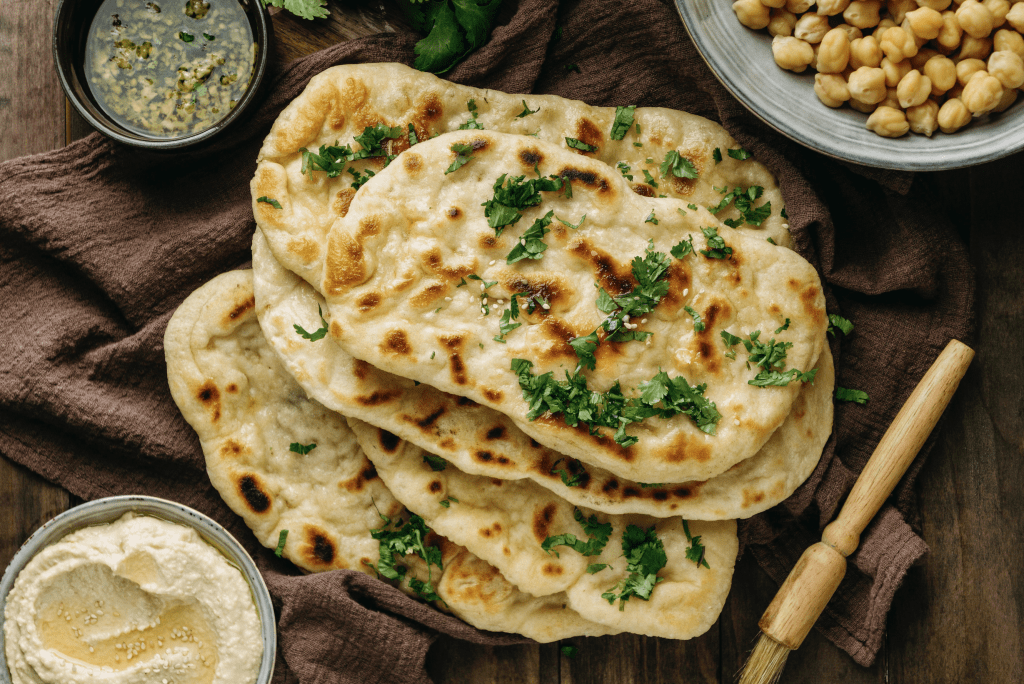In the vast landscape of world bread, few varieties have embedded themselves in international culinary traditions as impressively as naan. With its roots deeply ingrained in the Asian subcontinent, this flavorful flatbread has crossed cultural boundaries and today holds a prominent position in the global culinary sphere. The pillowy softness of naan is contrasted with the crispy surface, often punctuated with brown blisters from quick, high-heat cooking. Add to that an undercurrent of tangy sourdough, and you have a culinary fusion of global proportions. This article invites you on a journey to the origins of naan and walks you through crafting this delectable bread at home using sourdough.
The Cultural History of Naan
The origins of naan can be traced back to the earliest civilizations of the Indian subcontinent, around 2600 BC. The term ‘naan’ comes from the Persian language and translates to ‘bread’. It was the Persian and Middle Eastern influences that entered the region through the established trade routes that led to the invention of naan. In the radiant warmth of tandoor ovens, a culinary tradition was born that would span continents and centuries.
The essential characteristic of traditional naan is its soft, airy texture. This unique trait can be attributed to the use of yogurt and yeast, which together work to raise the dough, and the tandoor, a cylindrical clay oven, where the bread is slapped onto the sides to cook rapidly in extremely high heat.
Over the centuries, regional variants of naan have developed, each carrying unique characteristics reflective of their local gastronomic culture. For example, the Kashmiri naan is stuffed with dried fruits and nuts, while the Roghani naan from Afghanistan is sprinkled with poppy seeds. Regardless of the region, the communal act of breaking naan during meals serves as a symbol of unity, hospitality, and fellowship.
A Sourdough Spin on a Classic
In the West, naan found its way into the mainstream through Indian restaurants, which became a medium for sharing and celebrating South Asian culinary heritage. More recently, an intriguing twist on the traditional naan recipe has appeared – sourdough naan. A brainchild of the global sourdough revival, this naan version merges age-old fermentation methods with the cultural heritage of naan.
Sourdough, like naan, boasts a rich history, albeit rooted in the Western world. It leverages natural fermentation for leavening, thanks to a live culture of wild yeast and lactic acid bacteria. A well-maintained sourdough starter can live indefinitely, bringing a unique, complex flavor profile to any bread. The incorporation of sourdough into the naan preparation process lends an added layer of tanginess, resulting in an alluring blend of tastes and textures.
Crafting Sourdough Naan: A Step-by-Step Guide
Embarking on the journey of making sourdough naan at home is as much an exercise in patience as it is in artistry. The process begins with a healthy sourdough starter, the lifeline of any sourdough bread.
Sourdough Starter
For newcomers to sourdough baking, the starter is a mixture of flour and water that is left to ferment, cultivating natural yeasts and bacteria. Over several days, this mixture is periodically “fed” with more flour and water, which enables the starter to thrive and become a leavening agent.
Ingredients
For the sourdough naan, you will need:
- 1 cup sourdough starter (fed and active)
- 1/2 cup whole milk, warmed
- 2 tablespoons plain yogurt
- 2 tablespoons olive oil
- 2 cups all-purpose flour
- 1 teaspoon salt
- 1 teaspoon sugar
- Baking powder, 1/2 teaspoon (optional)
- Melted butter, fresh garlic, and cilantro for topping
Process
- Mix and Knead: Begin by combining the sourdough starter, warm milk, yogurt, and olive oil in a large bowl. Mix until it’s well incorporated. In another bowl, mix together the flour, salt, sugar, and baking powder (if using). Gradually add the dry mixture into the wet, stirring continuously until a rough dough forms. Knead the dough either by hand on a floured surface or with a mixer’s dough hook for about 10 minutes until it’s smooth and elastic.
- First Rise: Place the dough in a greased bowl, cover it with a damp cloth, and let it rise in a warm place for around 6-8 hours, or until it has visibly increased in size. This time allows for the sourdough starter to work its magic, fermenting the dough and developing complex flavors.
- Shape Naans: After the dough has risen, gently punch it down to release the gas built up during fermentation. Divide it into 8 equal parts. Using a rolling pin, roll each piece into an oval or teardrop shape that’s about a quarter inch thick.
- Cook: Traditionally, naan is cooked in a tandoor oven, but a cast-iron skillet or griddle will also work. Preheat your cooking surface over high heat, and once hot, place a rolled naan onto it. Cook until bubbles appear on the surface, then flip the naan and cook the other side. It should take 2-3 minutes per side.
- Finish and Serve: Immediately after removing from the heat, brush each naan with melted butter. You can also add minced garlic and fresh cilantro for additional flavor. Serve your sourdough naan warm, ideally alongside a flavorful curry or dip.
Creating sourdough naan at home is more than a culinary endeavor – it’s an opportunity to partake in centuries-old traditions, infusing the timeless appeal of sourdough with the rich history of naan. From the heart of the Asian subcontinent to kitchens worldwide, naan has indeed come a long way. And by introducing the tang of sourdough to the traditional recipe, we’re adding our own chapter to this ever-evolving tale of bread.
Dishes and Sides That Pair Well
Chole (Chickpea Curry): The robust flavors of chole are well balanced with the tangy sourdough naan.
Saag Paneer: The creaminess of this spinach and cheese dish pairs well with the tanginess of the sourdough naan.
Tandoori Masala Roasted Vegetables: The earthy and spicy flavors of these vegetables offer a contrast to the tangy sourdough naan.
Lamb Vindaloo: The fiery, tangy dish pairs excellently with sourdough naan. The tanginess of both complement each other while the bread helps temper the heat of the curry.
Tzatziki: This yogurt-based dip with cucumber and mint provides a cool and refreshing contrast to the tangy sourdough naan.
Dal Makhani: The rich, creamy lentils provide a great contrast to the tangy and chewy sourdough naan.
Ghee Roasted Potatoes: The crispy, savory potatoes provide a contrast to the soft, tangy naan bread.
Chicken Tikka Masala: The rich, creamy, and spiced sauce goes well with the tangy and soft sourdough naan.
Eggplant Bharta: The smoky and earthy flavor of roasted eggplant pairs well with the tangy sourdough naan.
Butter Chicken: This creamy, mildly-spiced dish provides a nice contrast to the tangy sourdough naan.
Aloo Gobi: This spiced cauliflower and potato dish offers a flavorful contrast to the sourdough naan.
Beef Kofta Curry: The tangy curry of the beef kofta pairs well with the sourdough naan.
Cucumber Raita: This refreshing, cool yogurt-based dip with cucumber is a great contrast to the tangy sourdough naan.
Kadai Paneer: The spicy and bell pepper-flavored paneer dish pairs well with the sourdough naan.
Mixed Vegetable Curry: The assorted vegetable flavors offer a tasty and balanced combination with sourdough naan.
Shrimp Curry: The spicy and flavorful shrimp curry provides a contrast to the sourdough naan.
Rogan Josh: This flavorful lamb curry pairs nicely with the tangy sourdough naan.
Biryani: The spiced, flavorful rice dish can be scooped up with the naan for a balanced bite.
Fish Amritsari: This battered fish dish offers a crispy contrast to the soft sourdough naan.
Kebabs: Whether it’s chicken, beef, or vegetable kebabs, sourdough naan bread can be used as a wrap, and the tangy flavor of the bread complements the spiced kebabs.





















